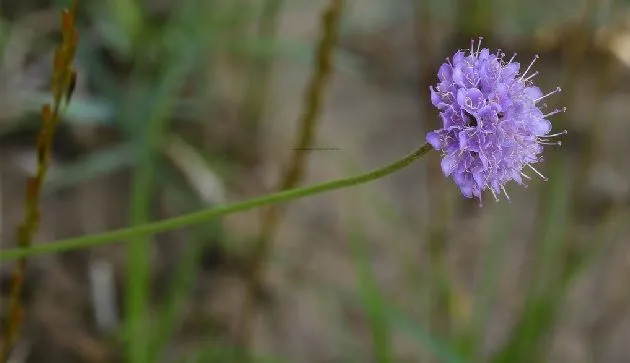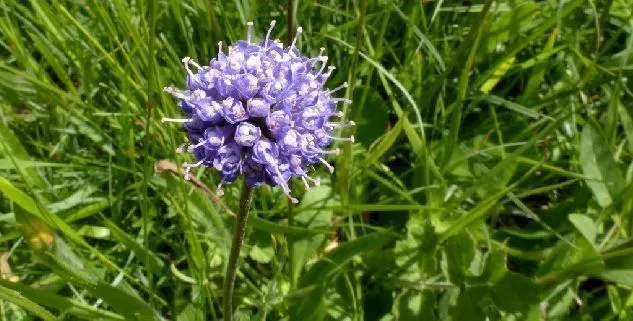We find today a plant that has a very striking common name. It is commonly known as devil’s bite, but its scientific name is succisa pratensis.
A herbaceous plant of a family not so well known in the botanical world, Caprifoliaceae. A succisa pratensis we can find it distributed in several European and North African areas, always looking for temperate zones with mild winters.
Its flowers form a circular inflorescence somewhat similar to that of the species belonging to the family Liliaceae, such as onion or garlic. They are purplish and pink in color and can reach up to 1 meter in height (although it is normal that they do not exceed 80 cm).
Where do you think the name of devil’s bite?
Legend has it in the areas where the plant was known and used succisa pratensis that the devil was rabid and envious about his medicinal properties, so he decided to take a bite of the root to punish it and prevent it from working again.
Table of Contents
Features of succisa pratensis

The devil’s bite starts from a very small rhizome, which forms the whole plant. It is considered a perennial herbaceous that can be grown in any open-air garden.
Its planting, using seeds, is carried out once the cold season has passed. A time that, remember, must be mild winters.
It can be planted in a situation of sun or semi-shade, but at least it must be able to enjoy good lighting 6 hours a day.
In areas where high temperatures are recorded in summer, such as in the Mediterranean basin or North Africa, in many cases it has adapted to indoor cultivation or in pots.
Although it is a plant that is accustomed to growing spontaneously in humid meadows and areas of medium rainfall, today it adapts to all types of soils and circumstances.
Long periods of drought impair the development of the devil’s bite plant, but it concentrates its active ingredients even more.
Seed cultivation
Germination is quite simple, and we can do it, in a seedbed a little before the entrance of spring or wait for the improvement of temperatures and plant it directly in the garden.
In March or April we can perform its germination and subsequent transplantation (either in pots or in the garden definitively).
Its germination is somewhat slower than many horticultural plants, seeing the first cotyledons come out from 3 weeks after the introduction of the seeds into the substrate.
Medicinal properties of Succisa pratensis
Medicinally, the parts of the plant used to take advantage of its active ingredients has been the rhizome, although for certain remedies parts of the leaves and flowers have also been chosen.
These rhizomes are collected from spring or once flowering has finished, in autumn, being more advisable to do it in autumn.
As for the leaves and flowers, they can be collected during flowering, selecting those larger and more showy.
Active ingredients and composition
- Starch
- Tannins
- Saponins
- Caffeic acid
- Mineral salts
- Glycosides
The importance of the medicinal properties of succisa pratensis they are awarded mainly for their content in tannins and saponins.
These compounds have a direct action to relieve symptoms related to breathing problems. Among them we mention a quick relief of cough, inflammation of the throat (angina, tonsillitis, pharyngitis, etc.) and bronchitis.
+ 7 Natural Cough Remedies
To do this, an infusion was prepared and taken several times a day.
However, it has also been known topical use (on the skin) of succisa pratensis.
Both the leaves and the root itself have antimicrobial potential. People rubbed over wounds or burns to relieve inflammation and prevent further infection.
Today, it is being studied which active ingredient can be attributed to this bacteriostatic or bactericidal effect.

Devil’s Bite Infusion Preparation
To prepare a S teauccisa pratensis, We will weigh between 1 and 2 grams of root of the plant and we will introduce it on the boiling water, once we have extinguished the fire and it is at rest.
We can take 2 to 3 cups a day
Side effects and contraindications of Succisa pratensis
To this day they are not well known or directly unknown possible side effects by ingestion by infusion of the devil’s bite plant.
Both for its composition in tannins, saponins and glycosides, applied on the skin could have some allergic effect on sensitive people. It is recommended to do a previous experience only in one part of the body to observe its evolution.
In general, it is always advisable to consult with a medical specialist to assess its use, not consuming it in pregnancy or lactation.
Did you know the medicinal properties of Succisa pratensis?
